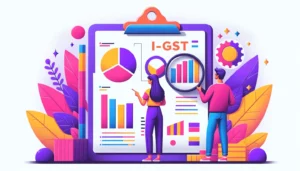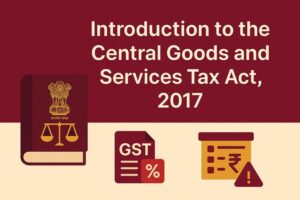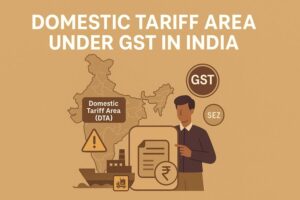Difference Between CGST, SGST and IGST: All You Need To Know
- 30 Aug 24
- 9 mins
Difference Between CGST, SGST and IGST: All You Need To Know
Key Takeaways
- GST Components: GST consists of CGST, SGST, IGST, and UTGST, each serving specific intra-state, inter-state, and Union Territory transactions.
- Intra-State vs. Inter-State: CGST and SGST apply to intra-state transactions, while IGST is for inter-state and import transactions.
- Tax Objectives: GST aims to unify multiple indirect taxes, eliminate the tax-on-tax system, and foster economic growth.
- Revenue Distribution: CGST and SGST revenue are shared by central and state governments, while IGST revenue is split between central and state governments.
- GST Slab Rates: GST rates vary by category, with normal rates of 0%, 5%, 12%, 18%, and 28%, and lower rates for specific schemes like the Composition Scheme.
Understanding the difference between the components of Goods and Services Tax is important for individuals and businesses alike who are liable to pay tax under the current regime. There are four main components: Central Goods and Services Tax (CGST), State Goods and Services Tax (SGST), Integrated Goods and Services Tax (IGST) and Union Territory Goods and Services Tax (UTGST).
While CGST and SGST apply to the intra-state supply of goods and services, IGST applies to inter-state and import transactions. The division of these components has many benefits. It primarily ensures a fair revenue distribution and a balanced tax structure in India.
This blog will focus on the key differences between CGST, SGST and IGST while highlighting all the associated details that you need to know.
What Is GST?

GST, also known as Goods and Service Tax, is an indirect tax that came into effect in India on July 1st, 2017. It has replaced indirect taxes such as central excise, service tax, state VAT, etc.
GST is a destination-based tax that is levied on value addition, i.e., all supply of goods and services. Currently, the goods and services tax is the single indirect tax for all domestic affairs of the entire country.
This tax is imposed at every stage of the sale. The tax that is levied during intrastate supply is known as CGST or SGST. During interstate supply, IGST is imposed.
Objectives of GST
The three objectives of Goods and Services Tax are as follows:
- Combining Multiple Indirect Taxes Under a Single Head
GST aims to replace multiple indirect tax regimes that previously existed such as VAT, excise duty, service tax, state VAT and many more. This makes the tax payment simpler for businesses and reduces their burden of tax liability considerably. By combining multiple indirect taxes under one single head, GST also aims to improve transparency.
- Eradicate the Tax-on-Tax System
Before the implementation of GST, the indirect tax structure of India was complex. This often led to the final consumer bearing the multiple taxation layers. GST introduced an input credit system, which is comprehensive. This eliminates the cascading effect of the tax-on-tax system, ensuring that taxes are levied only on value addition in the supply chain. As a result, it ultimately lowers costs for consumers.
- Better Economic Growth
One of the objectives of GST is to increase the economic growth of a country. It aims to achieve by rationalisation of supply chains, streamlining smooth transaction of goods and services and reduction of transportation expenses. The tax also aims to promote a unified market structure by eliminating barriers to inter-state trade.
Different Types of GST Tax
There are primarily 3 components of Goods and Services Tax—CGST, SGST, and IGST. Let us discuss them in detail.
- SGST
The tax that is levied on intra-state transactions by the State Government is known as the State Goods and Services Tax (SGST). Solely the state government earns the tax revenue at the place of the applicable transaction and is not liable to share with the Central Government. The benefit of SGST is that it streamlines taxation by consolidating multiple state-level taxes, such as entertainment tax, luxury tax, purchase tax, and Value-Added Tax (VAT), into a single, more efficient and transparent system.
- CGST
The central tax that the Central Government levies on intrastate transactions is known as the Central Goods and Services Tax. This tax is shared by the Central and the State governments equally as it is imposed with SGST or UGST. CGST subsumes other Central indirect taxes like cess, central excise duty, service tax, central surcharges, etc.
- IGST
In cases of interstate transactions, IGST applies to goods and services. The central and the state governments share the revenue among them equally. For instance, if Trader A from West Bengal makes an interstate sale to Trader C in Maharashtra, then Trader C will have to pay a combined rate of IGST of 18%
- UGST
If the transaction is between Union Territories like Andaman and Nicobar Islands, Pondicherry, Chandigarh, etc., a Union Territory Goods and Services Tax (UGST) is levied instead of SGST.
Who Is Liable to Pay GST?

Go through the list below for a fair understanding of who is liable to pay GST.
- Businesses
Business owners of any businesses, regardless of size, which make sales transactions are liable to pay GST.
- Manufacturers and Retailers
If you are a manufacturer of goods or are involved in retailing, you are likely to fall under tax liability.
- Exporters and Importers
If your business is involved in transactions that involve the import or export of goods, you are liable to pay GST.
- Taxpayers with GST Registration
If your business has reached a certain amount of annual turnover, you not only need to register under GST but are also liable to pay GST.
- Professional Services
Individuals who offer professional services like consultancy fall under the liability to pay GST.
Difference Between IGST, CGST and SGST
Take a look at the table to learn the 4 key differences between IGST, CGST and SGST.
| Basis of Distinction | IGST | SGST | CGST |
| Transactions | Inter-state transaction or supply of goods and services | Intra-state transaction of goods and services | Intra-state transaction of goods and services |
| Input Tax Credit | Input Tax Credit of IGST can be applied against either IGST, CGST, or SGST | Input Tax Credit is applicable against IGST or SGST, but not CGST | Input Tax Credit is applicable against IGST or CGST |
| Revenue Distribution | Revenue is shared between the central and the state governments. | The state government collects revenue | The central government collects revenue |
| Benefitting Authority | Central and state governments | State government | Central government |
Why Is GST Split into CGST, SGST and IGST?
Goods and Services Tax is split into CGST (Central Goods and Service Tax), SGST (State Goods & Services Tax), and IGST (Integrated Goods & Services Tax) because:
- It is done for a smooth distribution of tax revenues between the central and state governments.
- It ensures better clarity between inter and intra-state transactions.
Who Will Collect IGST in India?

The Central Government of India will collect Integrated Goods and Services Tax, in addition to customs duties, in case of inter-state supply of goods and services. The Central Government then shares the revenue among the Central and respective State governments, where the type of transaction took place.
How Does IGST Adjust with CGST and SGST?
IGST applies not only to transactions made between two states of the same country but also to two different countries. The rate of this tax is equal to the rate of CGST and the rate of SGST. The Central Government collects the tax revenue and divides the amount with the state government.
Let us understand this better with an example. Trader A from Mumbai makes a sale of ₹50,000 to Trader B who also resides in Mumbai. Trader B further sells the goods to Trader C in Delhi for ₹40,000. Finally, C sells it to Trader D who also resides in Delhi.
Assuming the transactions fall under a GST slab for the first intra-state transaction, the GST calculation is divided into CGST at 9% and SGST at 9%. For an inter-state transaction, the GST calculation is simplified into a single IGST at 18%.
How Is GST Related to CGST, SGST, IGST and Slab Rates?
For normal taxpayers, the GST slab rate is 0%, 0.25%, 3%, 5%, 12%, 18% and 28%. However, the GST rates of 3% and 0.25% are not much in use.
The applicable tax rates of taxpayers under the Composition Scheme are comparatively lower. These are mostly 1.5%, 5% or 6% of the total turnover.
The GST rates of Tax Collected at Source (TCS) or Tax Deducted at Source (TDS) are normal which are 1% and 2% respectively.
Take a look at the table below to learn about the GST slab rate of various goods and services in 2024:
| Categories | Old GST Rates | GST Rates in 2024 |
| Pens | 12% | 18% |
| Renewable Energy Devices | 5% | 12% |
| Printed Material | 12% | 18% |
| Polyurethanes and Scraps | 5% | 18% |
| Recorded Media and Print Services | 12% | 18% |
| Broadcasting, licensing, audio recordings | 12% | 18% |
Conclusion
The Goods and Services Tax (GST), along with its components- CGST, SGST (or UTGST) and IGST, simplify the tax structure of India, facilitate a unified market framework and reduce the cascading effect of tax-on-tax. Knowing the differences between CGST, SGST, and IGST is essential for ensuring accurate compliance with the regulations, thereby avoiding penalties and enabling smooth operations within the GST regime.
💡 If you want to pay your GST with Credit Card, then download Pice Business Payment App. Pice is the one stop app for paying all your business expenses.
 By
By 
















